Impact of Technology and Deindustrialisation on Global Work
VerifiedAdded on 2020/04/01
|13
|3783
|245
Report
AI Summary
This report delves into the multifaceted impact of technology and deindustrialisation on the global workplace, exploring the emergence of new work models such as the gig and on-demand economies, and the rise of flexible working arrangements. It examines how technological advancements are reshaping the workplace, influencing job satisfaction, and facilitating remote work. The report investigates the effects of automation and artificial intelligence on employment, alongside the rise of remote workers, digital technology, and freelancing. Furthermore, it analyzes the causes and consequences of deindustrialisation, including its impact on the workforce, unemployment, and reemployment. Drawing on secondary sources and interview data, the report provides a comprehensive overview of the changing nature of work in a technologically driven and deindustrializing world, offering insights into both the opportunities and challenges that these transformations present.
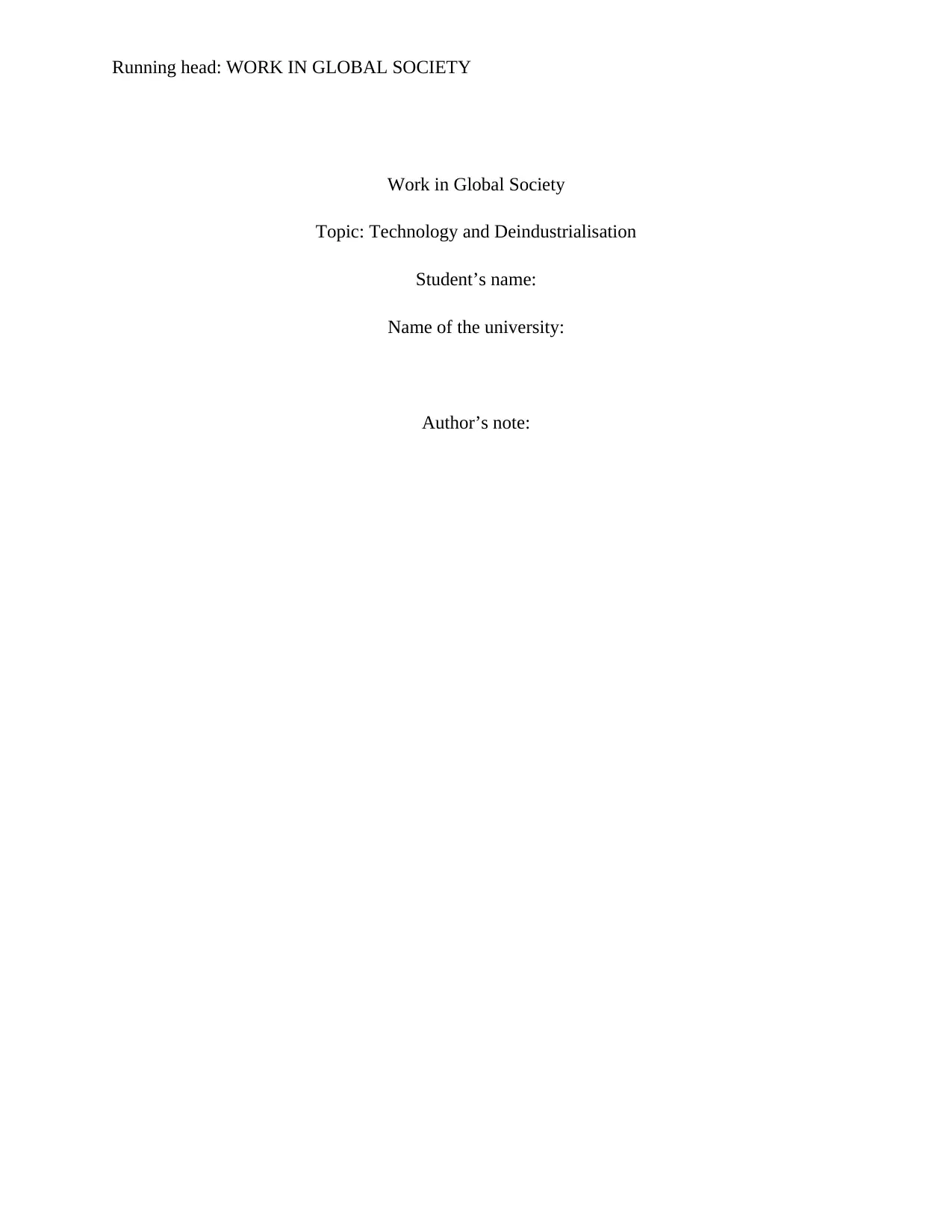
Running head: WORK IN GLOBAL SOCIETY
Work in Global Society
Topic: Technology and Deindustrialisation
Student’s name:
Name of the university:
Author’s note:
Work in Global Society
Topic: Technology and Deindustrialisation
Student’s name:
Name of the university:
Author’s note:
Paraphrase This Document
Need a fresh take? Get an instant paraphrase of this document with our AI Paraphraser
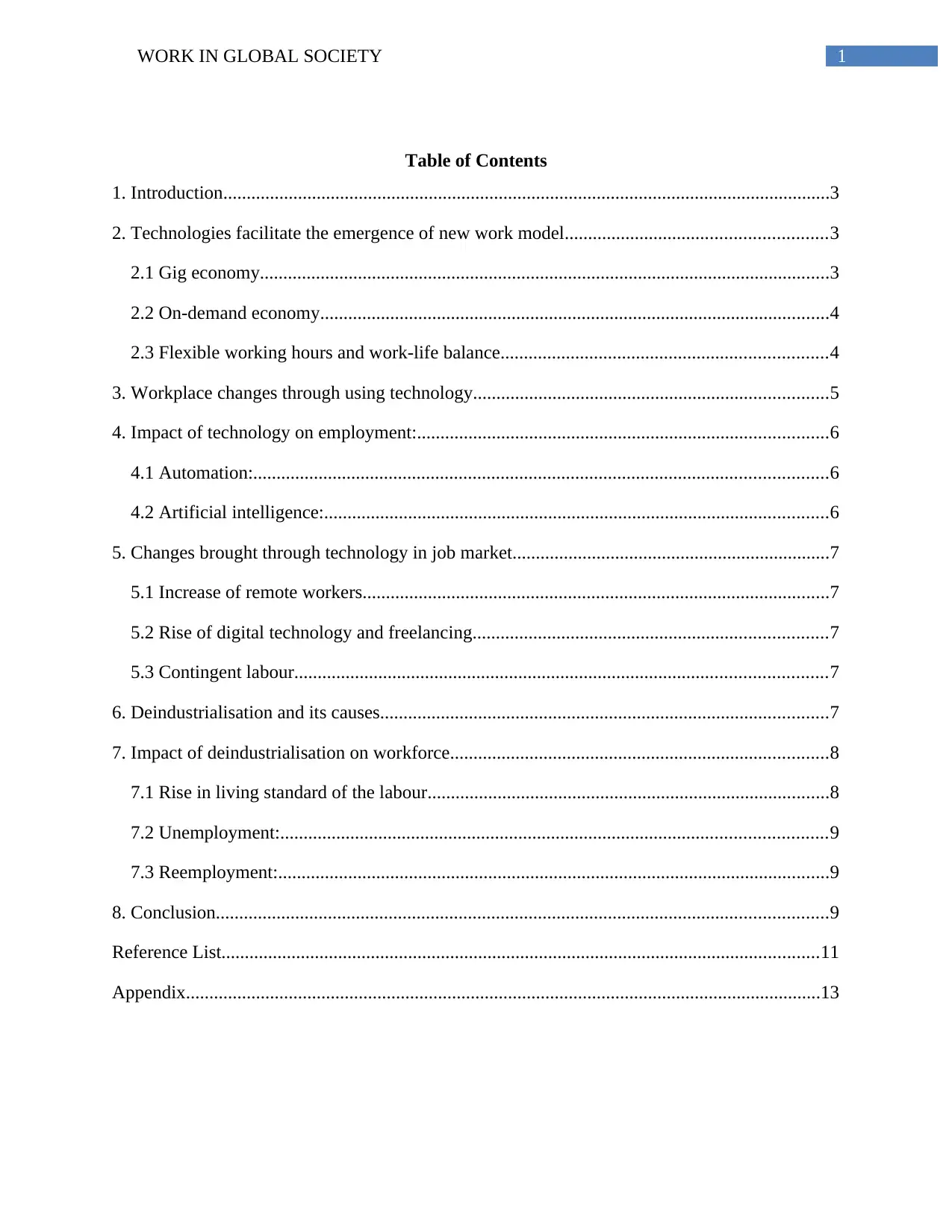
1WORK IN GLOBAL SOCIETY
Table of Contents
1. Introduction..................................................................................................................................3
2. Technologies facilitate the emergence of new work model........................................................3
2.1 Gig economy..........................................................................................................................3
2.2 On-demand economy.............................................................................................................4
2.3 Flexible working hours and work-life balance......................................................................4
3. Workplace changes through using technology............................................................................5
4. Impact of technology on employment:........................................................................................6
4.1 Automation:...........................................................................................................................6
4.2 Artificial intelligence:............................................................................................................6
5. Changes brought through technology in job market....................................................................7
5.1 Increase of remote workers....................................................................................................7
5.2 Rise of digital technology and freelancing............................................................................7
5.3 Contingent labour..................................................................................................................7
6. Deindustrialisation and its causes................................................................................................7
7. Impact of deindustrialisation on workforce.................................................................................8
7.1 Rise in living standard of the labour......................................................................................8
7.2 Unemployment:.....................................................................................................................9
7.3 Reemployment:......................................................................................................................9
8. Conclusion...................................................................................................................................9
Reference List................................................................................................................................11
Appendix........................................................................................................................................13
Table of Contents
1. Introduction..................................................................................................................................3
2. Technologies facilitate the emergence of new work model........................................................3
2.1 Gig economy..........................................................................................................................3
2.2 On-demand economy.............................................................................................................4
2.3 Flexible working hours and work-life balance......................................................................4
3. Workplace changes through using technology............................................................................5
4. Impact of technology on employment:........................................................................................6
4.1 Automation:...........................................................................................................................6
4.2 Artificial intelligence:............................................................................................................6
5. Changes brought through technology in job market....................................................................7
5.1 Increase of remote workers....................................................................................................7
5.2 Rise of digital technology and freelancing............................................................................7
5.3 Contingent labour..................................................................................................................7
6. Deindustrialisation and its causes................................................................................................7
7. Impact of deindustrialisation on workforce.................................................................................8
7.1 Rise in living standard of the labour......................................................................................8
7.2 Unemployment:.....................................................................................................................9
7.3 Reemployment:......................................................................................................................9
8. Conclusion...................................................................................................................................9
Reference List................................................................................................................................11
Appendix........................................................................................................................................13
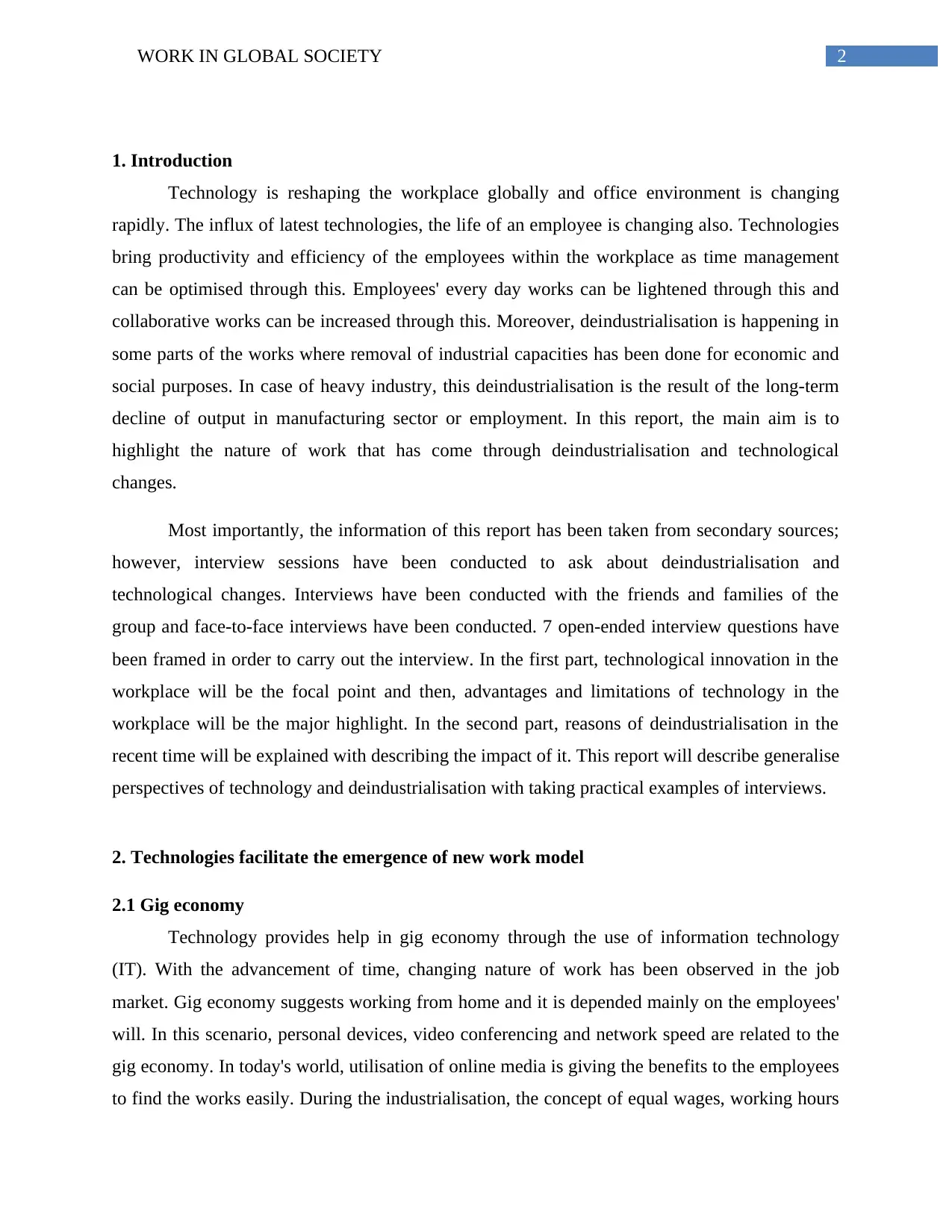
2WORK IN GLOBAL SOCIETY
1. Introduction
Technology is reshaping the workplace globally and office environment is changing
rapidly. The influx of latest technologies, the life of an employee is changing also. Technologies
bring productivity and efficiency of the employees within the workplace as time management
can be optimised through this. Employees' every day works can be lightened through this and
collaborative works can be increased through this. Moreover, deindustrialisation is happening in
some parts of the works where removal of industrial capacities has been done for economic and
social purposes. In case of heavy industry, this deindustrialisation is the result of the long-term
decline of output in manufacturing sector or employment. In this report, the main aim is to
highlight the nature of work that has come through deindustrialisation and technological
changes.
Most importantly, the information of this report has been taken from secondary sources;
however, interview sessions have been conducted to ask about deindustrialisation and
technological changes. Interviews have been conducted with the friends and families of the
group and face-to-face interviews have been conducted. 7 open-ended interview questions have
been framed in order to carry out the interview. In the first part, technological innovation in the
workplace will be the focal point and then, advantages and limitations of technology in the
workplace will be the major highlight. In the second part, reasons of deindustrialisation in the
recent time will be explained with describing the impact of it. This report will describe generalise
perspectives of technology and deindustrialisation with taking practical examples of interviews.
2. Technologies facilitate the emergence of new work model
2.1 Gig economy
Technology provides help in gig economy through the use of information technology
(IT). With the advancement of time, changing nature of work has been observed in the job
market. Gig economy suggests working from home and it is depended mainly on the employees'
will. In this scenario, personal devices, video conferencing and network speed are related to the
gig economy. In today's world, utilisation of online media is giving the benefits to the employees
to find the works easily. During the industrialisation, the concept of equal wages, working hours
1. Introduction
Technology is reshaping the workplace globally and office environment is changing
rapidly. The influx of latest technologies, the life of an employee is changing also. Technologies
bring productivity and efficiency of the employees within the workplace as time management
can be optimised through this. Employees' every day works can be lightened through this and
collaborative works can be increased through this. Moreover, deindustrialisation is happening in
some parts of the works where removal of industrial capacities has been done for economic and
social purposes. In case of heavy industry, this deindustrialisation is the result of the long-term
decline of output in manufacturing sector or employment. In this report, the main aim is to
highlight the nature of work that has come through deindustrialisation and technological
changes.
Most importantly, the information of this report has been taken from secondary sources;
however, interview sessions have been conducted to ask about deindustrialisation and
technological changes. Interviews have been conducted with the friends and families of the
group and face-to-face interviews have been conducted. 7 open-ended interview questions have
been framed in order to carry out the interview. In the first part, technological innovation in the
workplace will be the focal point and then, advantages and limitations of technology in the
workplace will be the major highlight. In the second part, reasons of deindustrialisation in the
recent time will be explained with describing the impact of it. This report will describe generalise
perspectives of technology and deindustrialisation with taking practical examples of interviews.
2. Technologies facilitate the emergence of new work model
2.1 Gig economy
Technology provides help in gig economy through the use of information technology
(IT). With the advancement of time, changing nature of work has been observed in the job
market. Gig economy suggests working from home and it is depended mainly on the employees'
will. In this scenario, personal devices, video conferencing and network speed are related to the
gig economy. In today's world, utilisation of online media is giving the benefits to the employees
to find the works easily. During the industrialisation, the concept of equal wages, working hours
⊘ This is a preview!⊘
Do you want full access?
Subscribe today to unlock all pages.

Trusted by 1+ million students worldwide
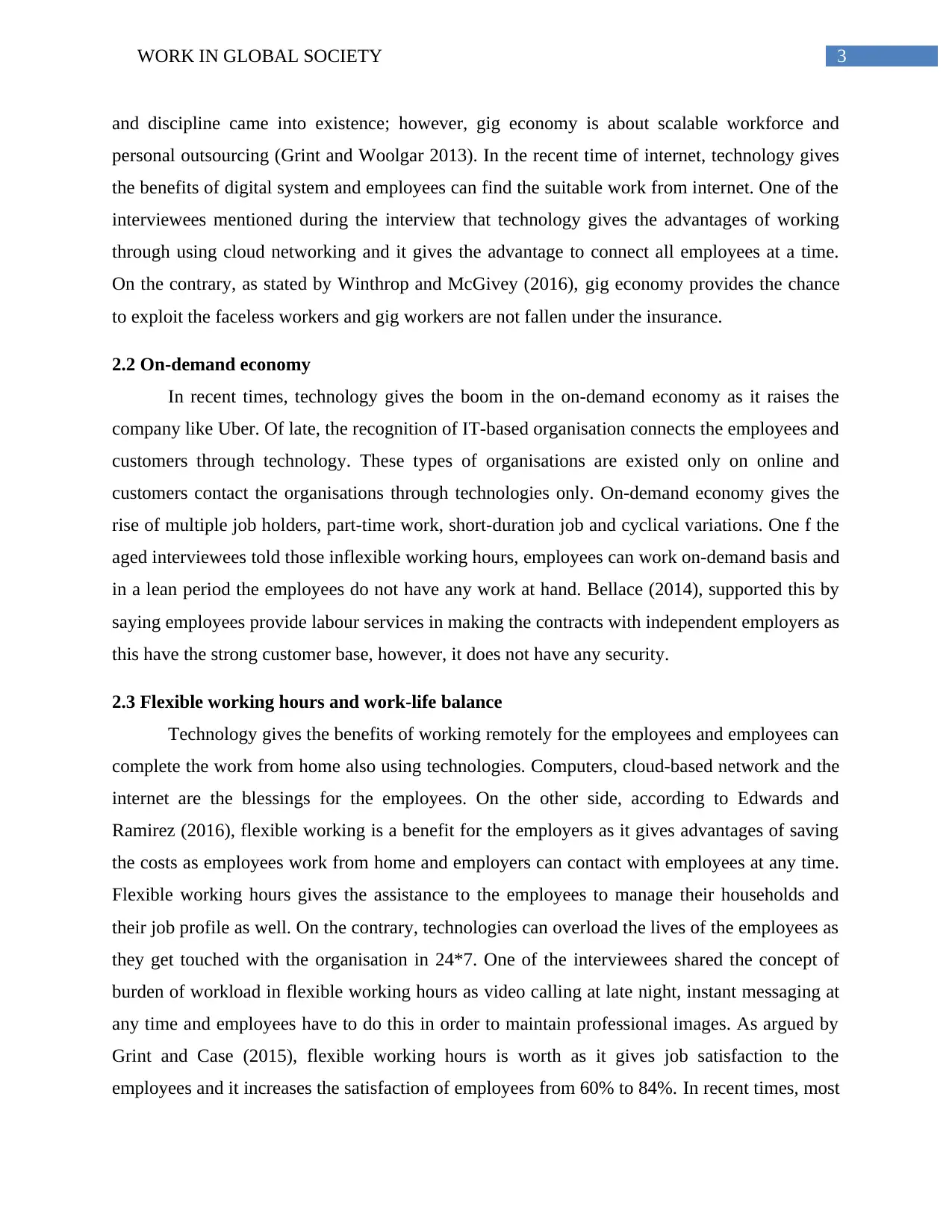
3WORK IN GLOBAL SOCIETY
and discipline came into existence; however, gig economy is about scalable workforce and
personal outsourcing (Grint and Woolgar 2013). In the recent time of internet, technology gives
the benefits of digital system and employees can find the suitable work from internet. One of the
interviewees mentioned during the interview that technology gives the advantages of working
through using cloud networking and it gives the advantage to connect all employees at a time.
On the contrary, as stated by Winthrop and McGivey (2016), gig economy provides the chance
to exploit the faceless workers and gig workers are not fallen under the insurance.
2.2 On-demand economy
In recent times, technology gives the boom in the on-demand economy as it raises the
company like Uber. Of late, the recognition of IT-based organisation connects the employees and
customers through technology. These types of organisations are existed only on online and
customers contact the organisations through technologies only. On-demand economy gives the
rise of multiple job holders, part-time work, short-duration job and cyclical variations. One f the
aged interviewees told those inflexible working hours, employees can work on-demand basis and
in a lean period the employees do not have any work at hand. Bellace (2014), supported this by
saying employees provide labour services in making the contracts with independent employers as
this have the strong customer base, however, it does not have any security.
2.3 Flexible working hours and work-life balance
Technology gives the benefits of working remotely for the employees and employees can
complete the work from home also using technologies. Computers, cloud-based network and the
internet are the blessings for the employees. On the other side, according to Edwards and
Ramirez (2016), flexible working is a benefit for the employers as it gives advantages of saving
the costs as employees work from home and employers can contact with employees at any time.
Flexible working hours gives the assistance to the employees to manage their households and
their job profile as well. On the contrary, technologies can overload the lives of the employees as
they get touched with the organisation in 24*7. One of the interviewees shared the concept of
burden of workload in flexible working hours as video calling at late night, instant messaging at
any time and employees have to do this in order to maintain professional images. As argued by
Grint and Case (2015), flexible working hours is worth as it gives job satisfaction to the
employees and it increases the satisfaction of employees from 60% to 84%. In recent times, most
and discipline came into existence; however, gig economy is about scalable workforce and
personal outsourcing (Grint and Woolgar 2013). In the recent time of internet, technology gives
the benefits of digital system and employees can find the suitable work from internet. One of the
interviewees mentioned during the interview that technology gives the advantages of working
through using cloud networking and it gives the advantage to connect all employees at a time.
On the contrary, as stated by Winthrop and McGivey (2016), gig economy provides the chance
to exploit the faceless workers and gig workers are not fallen under the insurance.
2.2 On-demand economy
In recent times, technology gives the boom in the on-demand economy as it raises the
company like Uber. Of late, the recognition of IT-based organisation connects the employees and
customers through technology. These types of organisations are existed only on online and
customers contact the organisations through technologies only. On-demand economy gives the
rise of multiple job holders, part-time work, short-duration job and cyclical variations. One f the
aged interviewees told those inflexible working hours, employees can work on-demand basis and
in a lean period the employees do not have any work at hand. Bellace (2014), supported this by
saying employees provide labour services in making the contracts with independent employers as
this have the strong customer base, however, it does not have any security.
2.3 Flexible working hours and work-life balance
Technology gives the benefits of working remotely for the employees and employees can
complete the work from home also using technologies. Computers, cloud-based network and the
internet are the blessings for the employees. On the other side, according to Edwards and
Ramirez (2016), flexible working is a benefit for the employers as it gives advantages of saving
the costs as employees work from home and employers can contact with employees at any time.
Flexible working hours gives the assistance to the employees to manage their households and
their job profile as well. On the contrary, technologies can overload the lives of the employees as
they get touched with the organisation in 24*7. One of the interviewees shared the concept of
burden of workload in flexible working hours as video calling at late night, instant messaging at
any time and employees have to do this in order to maintain professional images. As argued by
Grint and Case (2015), flexible working hours is worth as it gives job satisfaction to the
employees and it increases the satisfaction of employees from 60% to 84%. In recent times, most
Paraphrase This Document
Need a fresh take? Get an instant paraphrase of this document with our AI Paraphraser
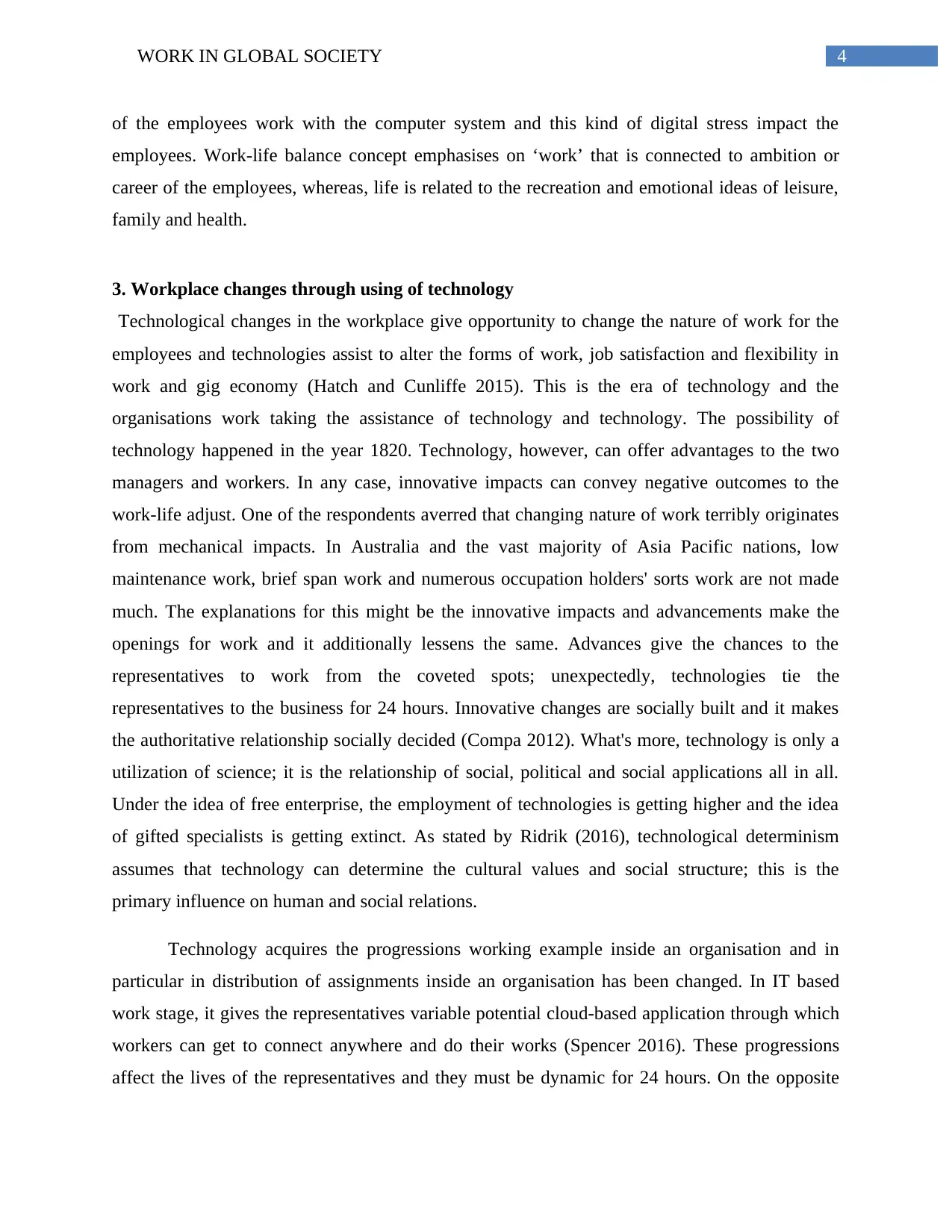
4WORK IN GLOBAL SOCIETY
of the employees work with the computer system and this kind of digital stress impact the
employees. Work-life balance concept emphasises on ‘work’ that is connected to ambition or
career of the employees, whereas, life is related to the recreation and emotional ideas of leisure,
family and health.
3. Workplace changes through using of technology
Technological changes in the workplace give opportunity to change the nature of work for the
employees and technologies assist to alter the forms of work, job satisfaction and flexibility in
work and gig economy (Hatch and Cunliffe 2015). This is the era of technology and the
organisations work taking the assistance of technology and technology. The possibility of
technology happened in the year 1820. Technology, however, can offer advantages to the two
managers and workers. In any case, innovative impacts can convey negative outcomes to the
work-life adjust. One of the respondents averred that changing nature of work terribly originates
from mechanical impacts. In Australia and the vast majority of Asia Pacific nations, low
maintenance work, brief span work and numerous occupation holders' sorts work are not made
much. The explanations for this might be the innovative impacts and advancements make the
openings for work and it additionally lessens the same. Advances give the chances to the
representatives to work from the coveted spots; unexpectedly, technologies tie the
representatives to the business for 24 hours. Innovative changes are socially built and it makes
the authoritative relationship socially decided (Compa 2012). What's more, technology is only a
utilization of science; it is the relationship of social, political and social applications all in all.
Under the idea of free enterprise, the employment of technologies is getting higher and the idea
of gifted specialists is getting extinct. As stated by Ridrik (2016), technological determinism
assumes that technology can determine the cultural values and social structure; this is the
primary influence on human and social relations.
Technology acquires the progressions working example inside an organisation and in
particular in distribution of assignments inside an organisation has been changed. In IT based
work stage, it gives the representatives variable potential cloud-based application through which
workers can get to connect anywhere and do their works (Spencer 2016). These progressions
affect the lives of the representatives and they must be dynamic for 24 hours. On the opposite
of the employees work with the computer system and this kind of digital stress impact the
employees. Work-life balance concept emphasises on ‘work’ that is connected to ambition or
career of the employees, whereas, life is related to the recreation and emotional ideas of leisure,
family and health.
3. Workplace changes through using of technology
Technological changes in the workplace give opportunity to change the nature of work for the
employees and technologies assist to alter the forms of work, job satisfaction and flexibility in
work and gig economy (Hatch and Cunliffe 2015). This is the era of technology and the
organisations work taking the assistance of technology and technology. The possibility of
technology happened in the year 1820. Technology, however, can offer advantages to the two
managers and workers. In any case, innovative impacts can convey negative outcomes to the
work-life adjust. One of the respondents averred that changing nature of work terribly originates
from mechanical impacts. In Australia and the vast majority of Asia Pacific nations, low
maintenance work, brief span work and numerous occupation holders' sorts work are not made
much. The explanations for this might be the innovative impacts and advancements make the
openings for work and it additionally lessens the same. Advances give the chances to the
representatives to work from the coveted spots; unexpectedly, technologies tie the
representatives to the business for 24 hours. Innovative changes are socially built and it makes
the authoritative relationship socially decided (Compa 2012). What's more, technology is only a
utilization of science; it is the relationship of social, political and social applications all in all.
Under the idea of free enterprise, the employment of technologies is getting higher and the idea
of gifted specialists is getting extinct. As stated by Ridrik (2016), technological determinism
assumes that technology can determine the cultural values and social structure; this is the
primary influence on human and social relations.
Technology acquires the progressions working example inside an organisation and in
particular in distribution of assignments inside an organisation has been changed. In IT based
work stage, it gives the representatives variable potential cloud-based application through which
workers can get to connect anywhere and do their works (Spencer 2016). These progressions
affect the lives of the representatives and they must be dynamic for 24 hours. On the opposite
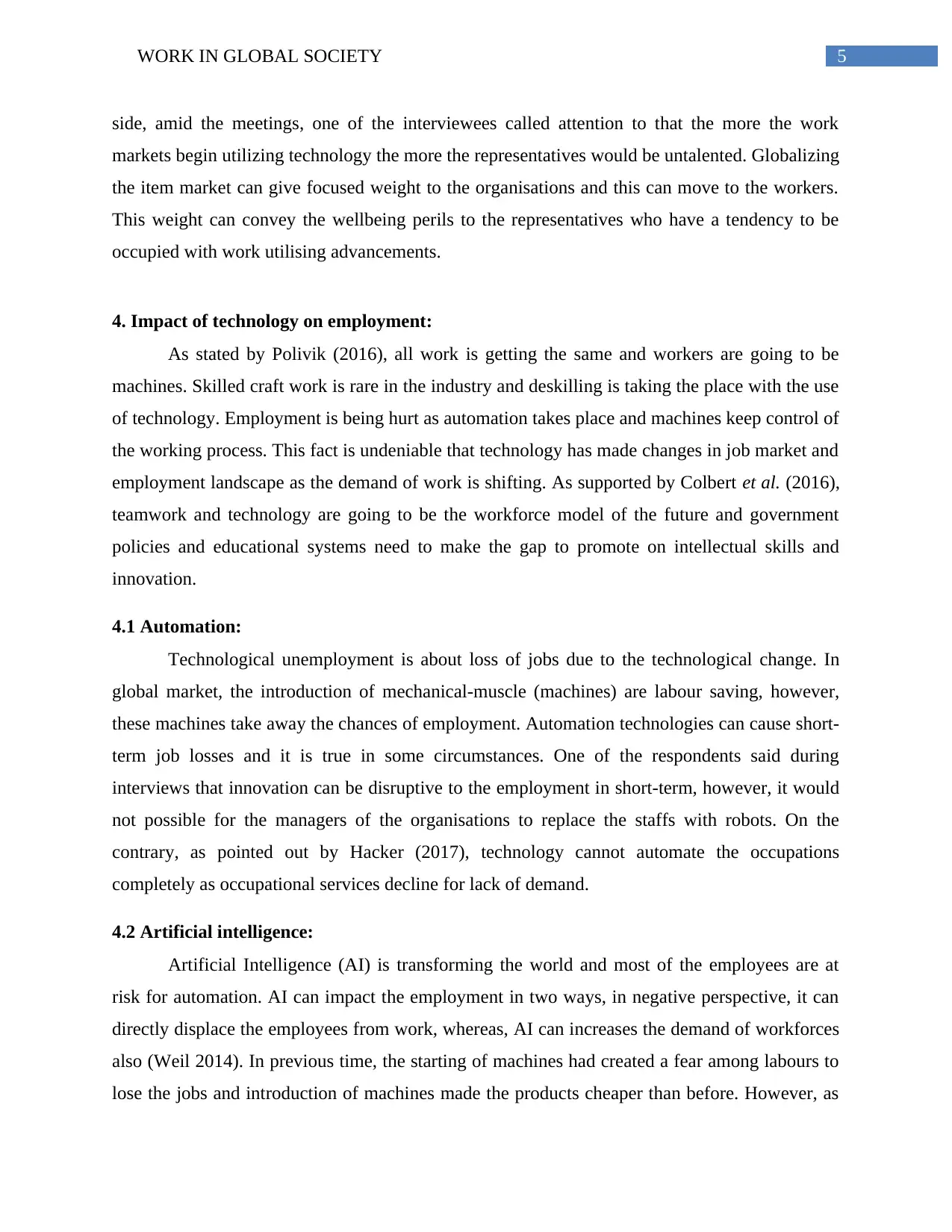
5WORK IN GLOBAL SOCIETY
side, amid the meetings, one of the interviewees called attention to that the more the work
markets begin utilizing technology the more the representatives would be untalented. Globalizing
the item market can give focused weight to the organisations and this can move to the workers.
This weight can convey the wellbeing perils to the representatives who have a tendency to be
occupied with work utilising advancements.
4. Impact of technology on employment:
As stated by Polivik (2016), all work is getting the same and workers are going to be
machines. Skilled craft work is rare in the industry and deskilling is taking the place with the use
of technology. Employment is being hurt as automation takes place and machines keep control of
the working process. This fact is undeniable that technology has made changes in job market and
employment landscape as the demand of work is shifting. As supported by Colbert et al. (2016),
teamwork and technology are going to be the workforce model of the future and government
policies and educational systems need to make the gap to promote on intellectual skills and
innovation.
4.1 Automation:
Technological unemployment is about loss of jobs due to the technological change. In
global market, the introduction of mechanical-muscle (machines) are labour saving, however,
these machines take away the chances of employment. Automation technologies can cause short-
term job losses and it is true in some circumstances. One of the respondents said during
interviews that innovation can be disruptive to the employment in short-term, however, it would
not possible for the managers of the organisations to replace the staffs with robots. On the
contrary, as pointed out by Hacker (2017), technology cannot automate the occupations
completely as occupational services decline for lack of demand.
4.2 Artificial intelligence:
Artificial Intelligence (AI) is transforming the world and most of the employees are at
risk for automation. AI can impact the employment in two ways, in negative perspective, it can
directly displace the employees from work, whereas, AI can increases the demand of workforces
also (Weil 2014). In previous time, the starting of machines had created a fear among labours to
lose the jobs and introduction of machines made the products cheaper than before. However, as
side, amid the meetings, one of the interviewees called attention to that the more the work
markets begin utilizing technology the more the representatives would be untalented. Globalizing
the item market can give focused weight to the organisations and this can move to the workers.
This weight can convey the wellbeing perils to the representatives who have a tendency to be
occupied with work utilising advancements.
4. Impact of technology on employment:
As stated by Polivik (2016), all work is getting the same and workers are going to be
machines. Skilled craft work is rare in the industry and deskilling is taking the place with the use
of technology. Employment is being hurt as automation takes place and machines keep control of
the working process. This fact is undeniable that technology has made changes in job market and
employment landscape as the demand of work is shifting. As supported by Colbert et al. (2016),
teamwork and technology are going to be the workforce model of the future and government
policies and educational systems need to make the gap to promote on intellectual skills and
innovation.
4.1 Automation:
Technological unemployment is about loss of jobs due to the technological change. In
global market, the introduction of mechanical-muscle (machines) are labour saving, however,
these machines take away the chances of employment. Automation technologies can cause short-
term job losses and it is true in some circumstances. One of the respondents said during
interviews that innovation can be disruptive to the employment in short-term, however, it would
not possible for the managers of the organisations to replace the staffs with robots. On the
contrary, as pointed out by Hacker (2017), technology cannot automate the occupations
completely as occupational services decline for lack of demand.
4.2 Artificial intelligence:
Artificial Intelligence (AI) is transforming the world and most of the employees are at
risk for automation. AI can impact the employment in two ways, in negative perspective, it can
directly displace the employees from work, whereas, AI can increases the demand of workforces
also (Weil 2014). In previous time, the starting of machines had created a fear among labours to
lose the jobs and introduction of machines made the products cheaper than before. However, as
⊘ This is a preview!⊘
Do you want full access?
Subscribe today to unlock all pages.

Trusted by 1+ million students worldwide
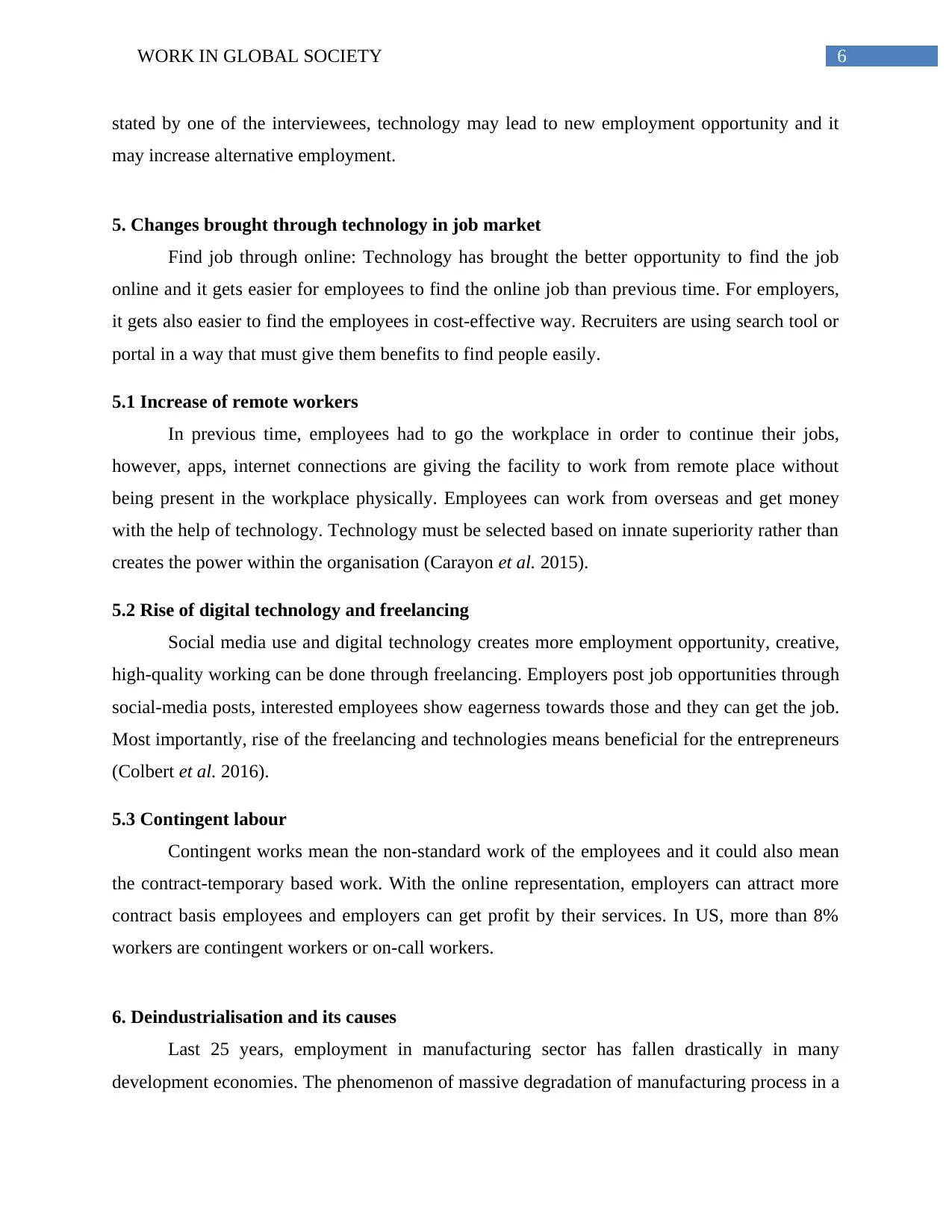
6WORK IN GLOBAL SOCIETY
stated by one of the interviewees, technology may lead to new employment opportunity and it
may increase alternative employment.
5. Changes brought through technology in job market
Find job through online: Technology has brought the better opportunity to find the job
online and it gets easier for employees to find the online job than previous time. For employers,
it gets also easier to find the employees in cost-effective way. Recruiters are using search tool or
portal in a way that must give them benefits to find people easily.
5.1 Increase of remote workers
In previous time, employees had to go the workplace in order to continue their jobs,
however, apps, internet connections are giving the facility to work from remote place without
being present in the workplace physically. Employees can work from overseas and get money
with the help of technology. Technology must be selected based on innate superiority rather than
creates the power within the organisation (Carayon et al. 2015).
5.2 Rise of digital technology and freelancing
Social media use and digital technology creates more employment opportunity, creative,
high-quality working can be done through freelancing. Employers post job opportunities through
social-media posts, interested employees show eagerness towards those and they can get the job.
Most importantly, rise of the freelancing and technologies means beneficial for the entrepreneurs
(Colbert et al. 2016).
5.3 Contingent labour
Contingent works mean the non-standard work of the employees and it could also mean
the contract-temporary based work. With the online representation, employers can attract more
contract basis employees and employers can get profit by their services. In US, more than 8%
workers are contingent workers or on-call workers.
6. Deindustrialisation and its causes
Last 25 years, employment in manufacturing sector has fallen drastically in many
development economies. The phenomenon of massive degradation of manufacturing process in a
stated by one of the interviewees, technology may lead to new employment opportunity and it
may increase alternative employment.
5. Changes brought through technology in job market
Find job through online: Technology has brought the better opportunity to find the job
online and it gets easier for employees to find the online job than previous time. For employers,
it gets also easier to find the employees in cost-effective way. Recruiters are using search tool or
portal in a way that must give them benefits to find people easily.
5.1 Increase of remote workers
In previous time, employees had to go the workplace in order to continue their jobs,
however, apps, internet connections are giving the facility to work from remote place without
being present in the workplace physically. Employees can work from overseas and get money
with the help of technology. Technology must be selected based on innate superiority rather than
creates the power within the organisation (Carayon et al. 2015).
5.2 Rise of digital technology and freelancing
Social media use and digital technology creates more employment opportunity, creative,
high-quality working can be done through freelancing. Employers post job opportunities through
social-media posts, interested employees show eagerness towards those and they can get the job.
Most importantly, rise of the freelancing and technologies means beneficial for the entrepreneurs
(Colbert et al. 2016).
5.3 Contingent labour
Contingent works mean the non-standard work of the employees and it could also mean
the contract-temporary based work. With the online representation, employers can attract more
contract basis employees and employers can get profit by their services. In US, more than 8%
workers are contingent workers or on-call workers.
6. Deindustrialisation and its causes
Last 25 years, employment in manufacturing sector has fallen drastically in many
development economies. The phenomenon of massive degradation of manufacturing process in a
Paraphrase This Document
Need a fresh take? Get an instant paraphrase of this document with our AI Paraphraser
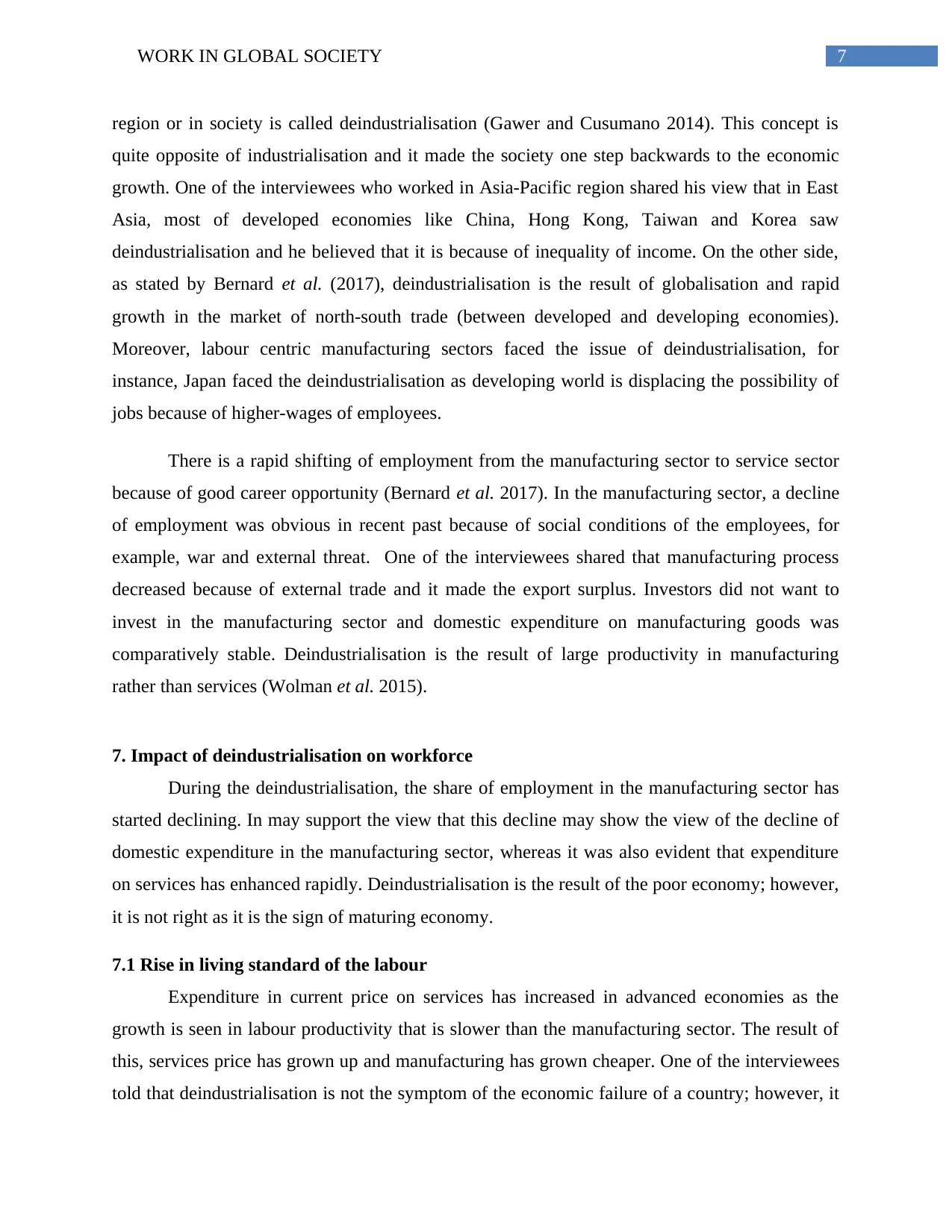
7WORK IN GLOBAL SOCIETY
region or in society is called deindustrialisation (Gawer and Cusumano 2014). This concept is
quite opposite of industrialisation and it made the society one step backwards to the economic
growth. One of the interviewees who worked in Asia-Pacific region shared his view that in East
Asia, most of developed economies like China, Hong Kong, Taiwan and Korea saw
deindustrialisation and he believed that it is because of inequality of income. On the other side,
as stated by Bernard et al. (2017), deindustrialisation is the result of globalisation and rapid
growth in the market of north-south trade (between developed and developing economies).
Moreover, labour centric manufacturing sectors faced the issue of deindustrialisation, for
instance, Japan faced the deindustrialisation as developing world is displacing the possibility of
jobs because of higher-wages of employees.
There is a rapid shifting of employment from the manufacturing sector to service sector
because of good career opportunity (Bernard et al. 2017). In the manufacturing sector, a decline
of employment was obvious in recent past because of social conditions of the employees, for
example, war and external threat. One of the interviewees shared that manufacturing process
decreased because of external trade and it made the export surplus. Investors did not want to
invest in the manufacturing sector and domestic expenditure on manufacturing goods was
comparatively stable. Deindustrialisation is the result of large productivity in manufacturing
rather than services (Wolman et al. 2015).
7. Impact of deindustrialisation on workforce
During the deindustrialisation, the share of employment in the manufacturing sector has
started declining. In may support the view that this decline may show the view of the decline of
domestic expenditure in the manufacturing sector, whereas it was also evident that expenditure
on services has enhanced rapidly. Deindustrialisation is the result of the poor economy; however,
it is not right as it is the sign of maturing economy.
7.1 Rise in living standard of the labour
Expenditure in current price on services has increased in advanced economies as the
growth is seen in labour productivity that is slower than the manufacturing sector. The result of
this, services price has grown up and manufacturing has grown cheaper. One of the interviewees
told that deindustrialisation is not the symptom of the economic failure of a country; however, it
region or in society is called deindustrialisation (Gawer and Cusumano 2014). This concept is
quite opposite of industrialisation and it made the society one step backwards to the economic
growth. One of the interviewees who worked in Asia-Pacific region shared his view that in East
Asia, most of developed economies like China, Hong Kong, Taiwan and Korea saw
deindustrialisation and he believed that it is because of inequality of income. On the other side,
as stated by Bernard et al. (2017), deindustrialisation is the result of globalisation and rapid
growth in the market of north-south trade (between developed and developing economies).
Moreover, labour centric manufacturing sectors faced the issue of deindustrialisation, for
instance, Japan faced the deindustrialisation as developing world is displacing the possibility of
jobs because of higher-wages of employees.
There is a rapid shifting of employment from the manufacturing sector to service sector
because of good career opportunity (Bernard et al. 2017). In the manufacturing sector, a decline
of employment was obvious in recent past because of social conditions of the employees, for
example, war and external threat. One of the interviewees shared that manufacturing process
decreased because of external trade and it made the export surplus. Investors did not want to
invest in the manufacturing sector and domestic expenditure on manufacturing goods was
comparatively stable. Deindustrialisation is the result of large productivity in manufacturing
rather than services (Wolman et al. 2015).
7. Impact of deindustrialisation on workforce
During the deindustrialisation, the share of employment in the manufacturing sector has
started declining. In may support the view that this decline may show the view of the decline of
domestic expenditure in the manufacturing sector, whereas it was also evident that expenditure
on services has enhanced rapidly. Deindustrialisation is the result of the poor economy; however,
it is not right as it is the sign of maturing economy.
7.1 Rise in living standard of the labour
Expenditure in current price on services has increased in advanced economies as the
growth is seen in labour productivity that is slower than the manufacturing sector. The result of
this, services price has grown up and manufacturing has grown cheaper. One of the interviewees
told that deindustrialisation is not the symptom of the economic failure of a country; however, it
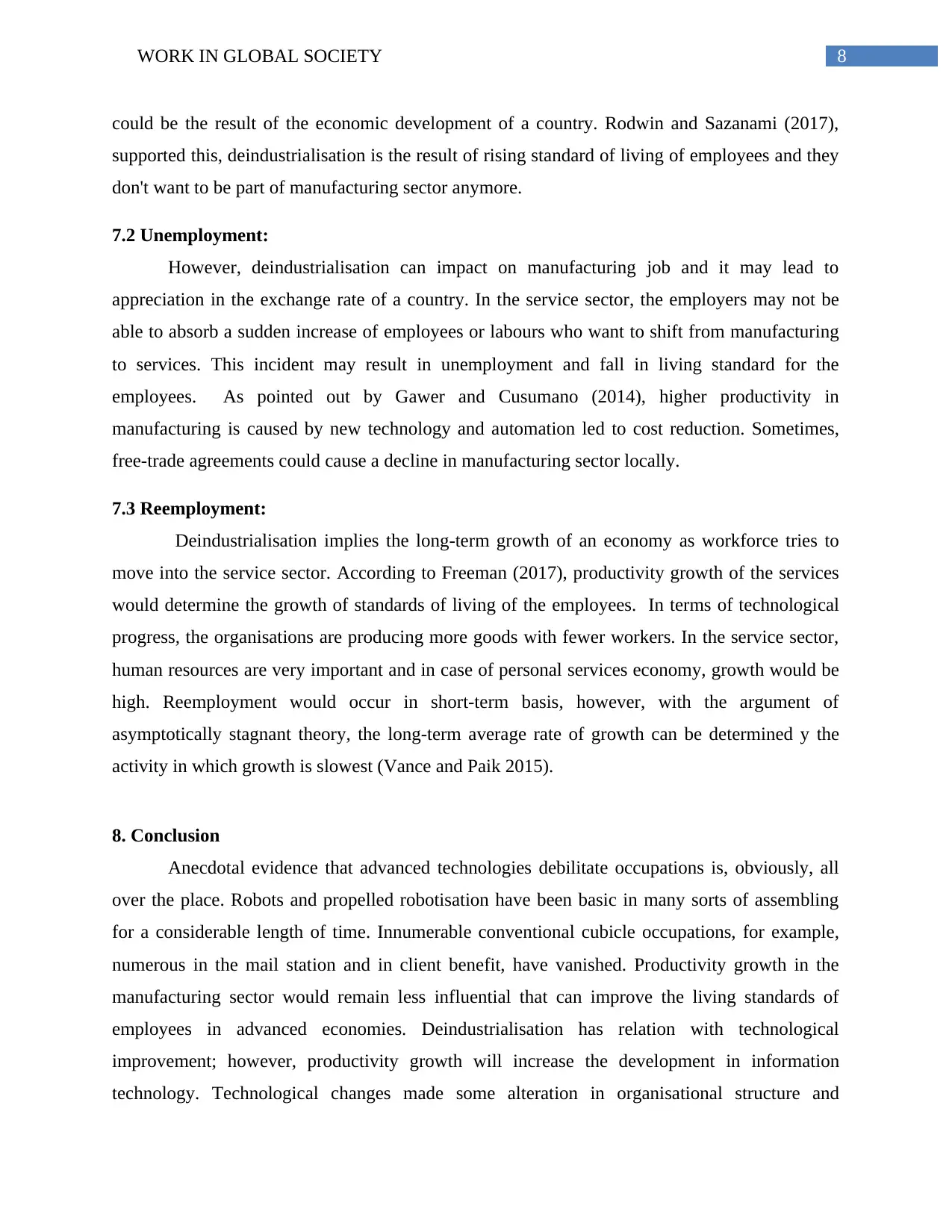
8WORK IN GLOBAL SOCIETY
could be the result of the economic development of a country. Rodwin and Sazanami (2017),
supported this, deindustrialisation is the result of rising standard of living of employees and they
don't want to be part of manufacturing sector anymore.
7.2 Unemployment:
However, deindustrialisation can impact on manufacturing job and it may lead to
appreciation in the exchange rate of a country. In the service sector, the employers may not be
able to absorb a sudden increase of employees or labours who want to shift from manufacturing
to services. This incident may result in unemployment and fall in living standard for the
employees. As pointed out by Gawer and Cusumano (2014), higher productivity in
manufacturing is caused by new technology and automation led to cost reduction. Sometimes,
free-trade agreements could cause a decline in manufacturing sector locally.
7.3 Reemployment:
Deindustrialisation implies the long-term growth of an economy as workforce tries to
move into the service sector. According to Freeman (2017), productivity growth of the services
would determine the growth of standards of living of the employees. In terms of technological
progress, the organisations are producing more goods with fewer workers. In the service sector,
human resources are very important and in case of personal services economy, growth would be
high. Reemployment would occur in short-term basis, however, with the argument of
asymptotically stagnant theory, the long-term average rate of growth can be determined y the
activity in which growth is slowest (Vance and Paik 2015).
8. Conclusion
Anecdotal evidence that advanced technologies debilitate occupations is, obviously, all
over the place. Robots and propelled robotisation have been basic in many sorts of assembling
for a considerable length of time. Innumerable conventional cubicle occupations, for example,
numerous in the mail station and in client benefit, have vanished. Productivity growth in the
manufacturing sector would remain less influential that can improve the living standards of
employees in advanced economies. Deindustrialisation has relation with technological
improvement; however, productivity growth will increase the development in information
technology. Technological changes made some alteration in organisational structure and
could be the result of the economic development of a country. Rodwin and Sazanami (2017),
supported this, deindustrialisation is the result of rising standard of living of employees and they
don't want to be part of manufacturing sector anymore.
7.2 Unemployment:
However, deindustrialisation can impact on manufacturing job and it may lead to
appreciation in the exchange rate of a country. In the service sector, the employers may not be
able to absorb a sudden increase of employees or labours who want to shift from manufacturing
to services. This incident may result in unemployment and fall in living standard for the
employees. As pointed out by Gawer and Cusumano (2014), higher productivity in
manufacturing is caused by new technology and automation led to cost reduction. Sometimes,
free-trade agreements could cause a decline in manufacturing sector locally.
7.3 Reemployment:
Deindustrialisation implies the long-term growth of an economy as workforce tries to
move into the service sector. According to Freeman (2017), productivity growth of the services
would determine the growth of standards of living of the employees. In terms of technological
progress, the organisations are producing more goods with fewer workers. In the service sector,
human resources are very important and in case of personal services economy, growth would be
high. Reemployment would occur in short-term basis, however, with the argument of
asymptotically stagnant theory, the long-term average rate of growth can be determined y the
activity in which growth is slowest (Vance and Paik 2015).
8. Conclusion
Anecdotal evidence that advanced technologies debilitate occupations is, obviously, all
over the place. Robots and propelled robotisation have been basic in many sorts of assembling
for a considerable length of time. Innumerable conventional cubicle occupations, for example,
numerous in the mail station and in client benefit, have vanished. Productivity growth in the
manufacturing sector would remain less influential that can improve the living standards of
employees in advanced economies. Deindustrialisation has relation with technological
improvement; however, productivity growth will increase the development in information
technology. Technological changes made some alteration in organisational structure and
⊘ This is a preview!⊘
Do you want full access?
Subscribe today to unlock all pages.

Trusted by 1+ million students worldwide

9WORK IN GLOBAL SOCIETY
deindustrialisation created pressure on the services sector. Product innovation is another
important factor as the manufacturing sector is now spilling over currently.
deindustrialisation created pressure on the services sector. Product innovation is another
important factor as the manufacturing sector is now spilling over currently.
Paraphrase This Document
Need a fresh take? Get an instant paraphrase of this document with our AI Paraphraser
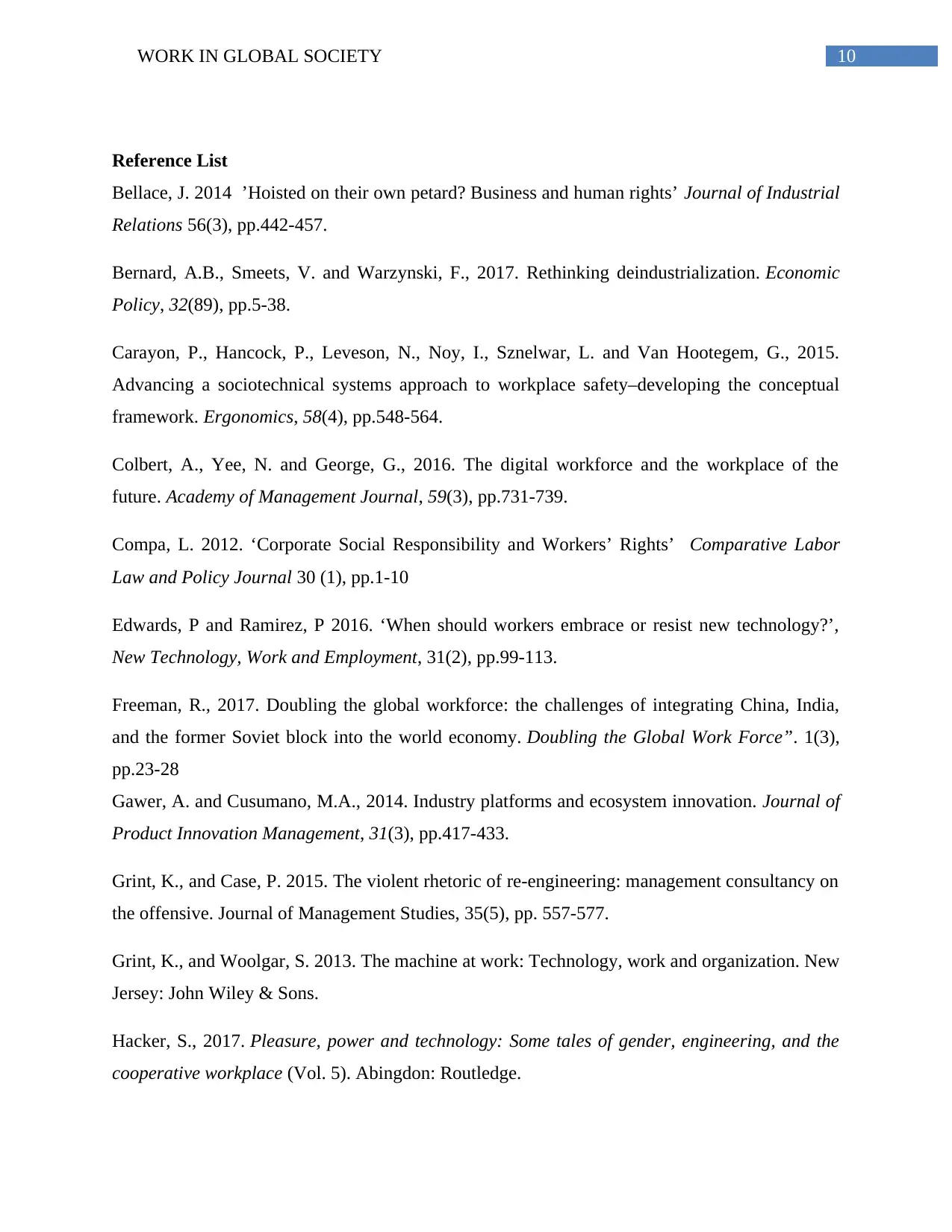
10WORK IN GLOBAL SOCIETY
Reference List
Bellace, J. 2014 ’Hoisted on their own petard? Business and human rights’ Journal of Industrial
Relations 56(3), pp.442-457.
Bernard, A.B., Smeets, V. and Warzynski, F., 2017. Rethinking deindustrialization. Economic
Policy, 32(89), pp.5-38.
Carayon, P., Hancock, P., Leveson, N., Noy, I., Sznelwar, L. and Van Hootegem, G., 2015.
Advancing a sociotechnical systems approach to workplace safety–developing the conceptual
framework. Ergonomics, 58(4), pp.548-564.
Colbert, A., Yee, N. and George, G., 2016. The digital workforce and the workplace of the
future. Academy of Management Journal, 59(3), pp.731-739.
Compa, L. 2012. ‘Corporate Social Responsibility and Workers’ Rights’ Comparative Labor
Law and Policy Journal 30 (1), pp.1-10
Edwards, P and Ramirez, P 2016. ‘When should workers embrace or resist new technology?’,
New Technology, Work and Employment, 31(2), pp.99-113.
Freeman, R., 2017. Doubling the global workforce: the challenges of integrating China, India,
and the former Soviet block into the world economy. Doubling the Global Work Force”. 1(3),
pp.23-28
Gawer, A. and Cusumano, M.A., 2014. Industry platforms and ecosystem innovation. Journal of
Product Innovation Management, 31(3), pp.417-433.
Grint, K., and Case, P. 2015. The violent rhetoric of re‐engineering: management consultancy on
the offensive. Journal of Management Studies, 35(5), pp. 557-577.
Grint, K., and Woolgar, S. 2013. The machine at work: Technology, work and organization. New
Jersey: John Wiley & Sons.
Hacker, S., 2017. Pleasure, power and technology: Some tales of gender, engineering, and the
cooperative workplace (Vol. 5). Abingdon: Routledge.
Reference List
Bellace, J. 2014 ’Hoisted on their own petard? Business and human rights’ Journal of Industrial
Relations 56(3), pp.442-457.
Bernard, A.B., Smeets, V. and Warzynski, F., 2017. Rethinking deindustrialization. Economic
Policy, 32(89), pp.5-38.
Carayon, P., Hancock, P., Leveson, N., Noy, I., Sznelwar, L. and Van Hootegem, G., 2015.
Advancing a sociotechnical systems approach to workplace safety–developing the conceptual
framework. Ergonomics, 58(4), pp.548-564.
Colbert, A., Yee, N. and George, G., 2016. The digital workforce and the workplace of the
future. Academy of Management Journal, 59(3), pp.731-739.
Compa, L. 2012. ‘Corporate Social Responsibility and Workers’ Rights’ Comparative Labor
Law and Policy Journal 30 (1), pp.1-10
Edwards, P and Ramirez, P 2016. ‘When should workers embrace or resist new technology?’,
New Technology, Work and Employment, 31(2), pp.99-113.
Freeman, R., 2017. Doubling the global workforce: the challenges of integrating China, India,
and the former Soviet block into the world economy. Doubling the Global Work Force”. 1(3),
pp.23-28
Gawer, A. and Cusumano, M.A., 2014. Industry platforms and ecosystem innovation. Journal of
Product Innovation Management, 31(3), pp.417-433.
Grint, K., and Case, P. 2015. The violent rhetoric of re‐engineering: management consultancy on
the offensive. Journal of Management Studies, 35(5), pp. 557-577.
Grint, K., and Woolgar, S. 2013. The machine at work: Technology, work and organization. New
Jersey: John Wiley & Sons.
Hacker, S., 2017. Pleasure, power and technology: Some tales of gender, engineering, and the
cooperative workplace (Vol. 5). Abingdon: Routledge.
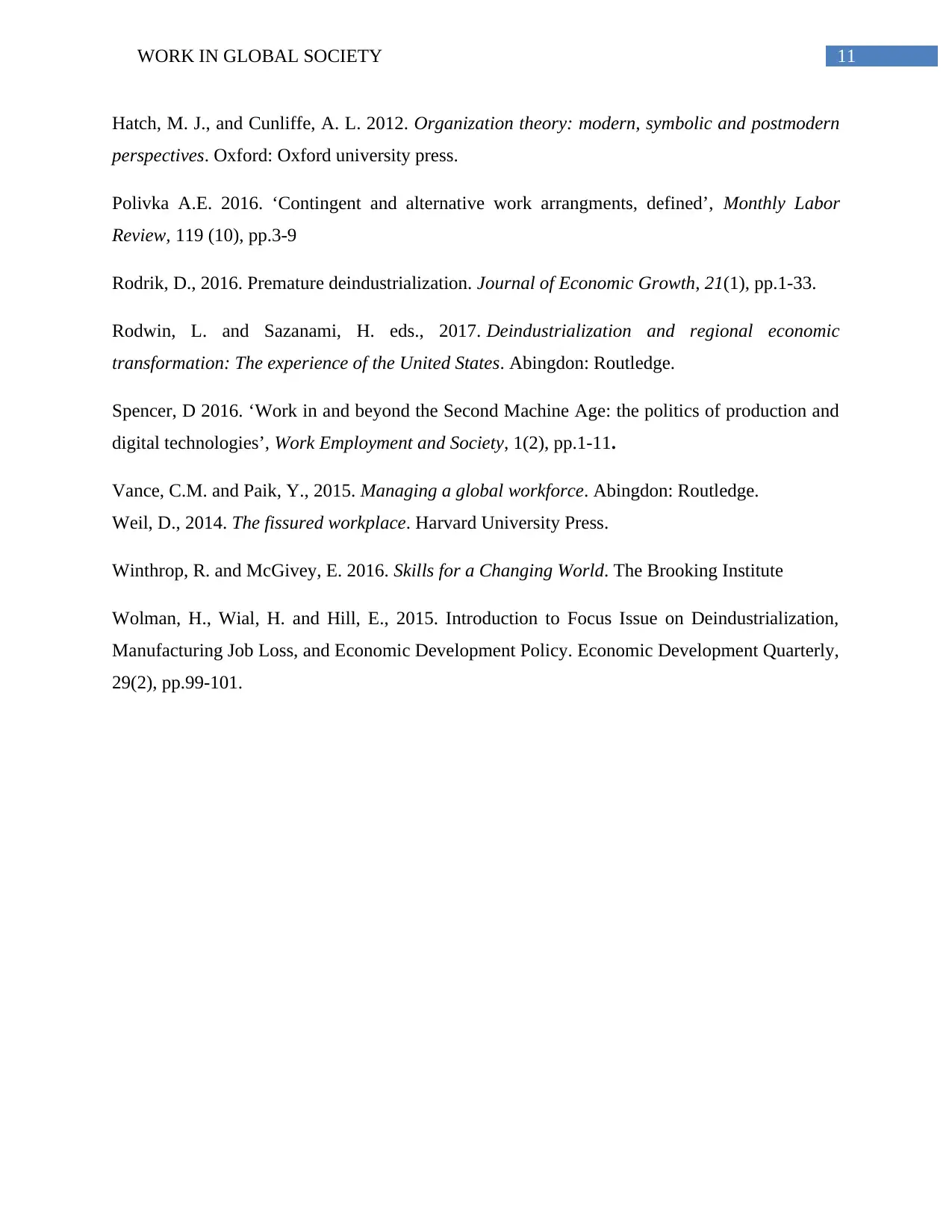
11WORK IN GLOBAL SOCIETY
Hatch, M. J., and Cunliffe, A. L. 2012. Organization theory: modern, symbolic and postmodern
perspectives. Oxford: Oxford university press.
Polivka A.E. 2016. ‘Contingent and alternative work arrangments, defined’, Monthly Labor
Review, 119 (10), pp.3-9
Rodrik, D., 2016. Premature deindustrialization. Journal of Economic Growth, 21(1), pp.1-33.
Rodwin, L. and Sazanami, H. eds., 2017. Deindustrialization and regional economic
transformation: The experience of the United States. Abingdon: Routledge.
Spencer, D 2016. ‘Work in and beyond the Second Machine Age: the politics of production and
digital technologies’, Work Employment and Society, 1(2), pp.1-11.
Vance, C.M. and Paik, Y., 2015. Managing a global workforce. Abingdon: Routledge.
Weil, D., 2014. The fissured workplace. Harvard University Press.
Winthrop, R. and McGivey, E. 2016. Skills for a Changing World. The Brooking Institute
Wolman, H., Wial, H. and Hill, E., 2015. Introduction to Focus Issue on Deindustrialization,
Manufacturing Job Loss, and Economic Development Policy. Economic Development Quarterly,
29(2), pp.99-101.
Hatch, M. J., and Cunliffe, A. L. 2012. Organization theory: modern, symbolic and postmodern
perspectives. Oxford: Oxford university press.
Polivka A.E. 2016. ‘Contingent and alternative work arrangments, defined’, Monthly Labor
Review, 119 (10), pp.3-9
Rodrik, D., 2016. Premature deindustrialization. Journal of Economic Growth, 21(1), pp.1-33.
Rodwin, L. and Sazanami, H. eds., 2017. Deindustrialization and regional economic
transformation: The experience of the United States. Abingdon: Routledge.
Spencer, D 2016. ‘Work in and beyond the Second Machine Age: the politics of production and
digital technologies’, Work Employment and Society, 1(2), pp.1-11.
Vance, C.M. and Paik, Y., 2015. Managing a global workforce. Abingdon: Routledge.
Weil, D., 2014. The fissured workplace. Harvard University Press.
Winthrop, R. and McGivey, E. 2016. Skills for a Changing World. The Brooking Institute
Wolman, H., Wial, H. and Hill, E., 2015. Introduction to Focus Issue on Deindustrialization,
Manufacturing Job Loss, and Economic Development Policy. Economic Development Quarterly,
29(2), pp.99-101.
⊘ This is a preview!⊘
Do you want full access?
Subscribe today to unlock all pages.

Trusted by 1+ million students worldwide
1 out of 13
Related Documents
Your All-in-One AI-Powered Toolkit for Academic Success.
+13062052269
info@desklib.com
Available 24*7 on WhatsApp / Email
![[object Object]](/_next/static/media/star-bottom.7253800d.svg)
Unlock your academic potential
Copyright © 2020–2025 A2Z Services. All Rights Reserved. Developed and managed by ZUCOL.





